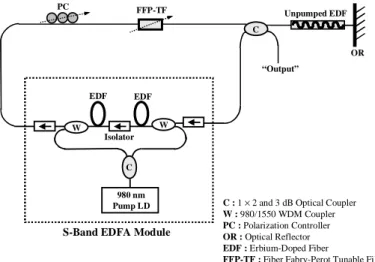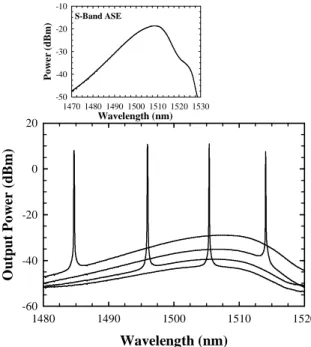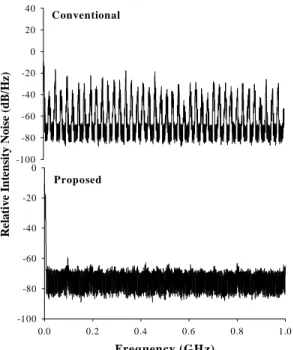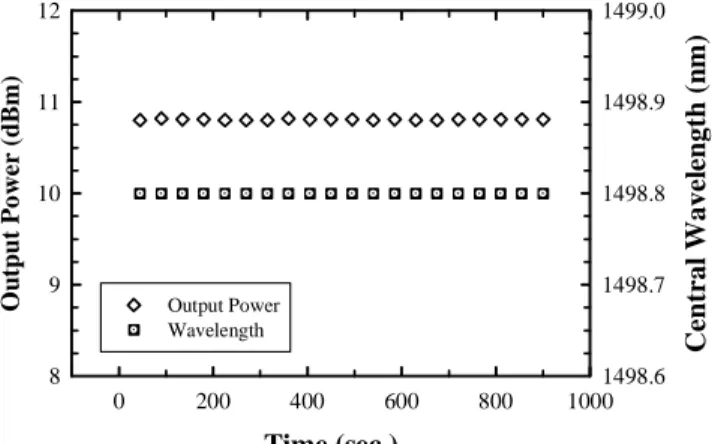Stabilized and wavelength-tunable S-Band
erbium-doped fiber ring laser with
single-longitudinal-mode operation
Chien-Hung Yeh 1, Ming-Ching Lin 2, and Sien Chi 2, 3
1 Transmission System Department, Computer and Communications Research Laboratories, Industrial Technology Research Institute, Chutung, Hsinchu 310, Taiwan
2 Department of Photonics and Institute of Electro-Optical Engineering, National Chiao Tung University, Hsinchu 300, Taiwan 3
Department of Electrical Engineering, Yuan Ze University, Chung-Li 320, Taiwan depew@itri.org.tw
Abstract: A stable and wavelength-tunable S-band erbium-doped fiber (EDF) ring laser with single-longitudinal-mode oscillation over the operating range of 1480.6 to 1522.9 nm is proposed and experimentally demonstrated. The proposed ring laser provides a fine mode restriction and guarantees the single-frequency operation based on a shorter length EDF serving as auto-tracking filter. Therefore, the performances of output power of > 10 dBm, power stability of < 0.05 dB, central wavelength variation of < 0.01 nm, and side-mode suppression ratio (SMSR) of > 49.1 dB have been experimentally demonstrated in the operating range of 1488.7 to 1505.7 nm.
©2005 Optical Society of America
OCIS codes: (060.2330) Fiber optics communications; (060.2320) Fiber optics amplifiers and
oscillators; (060.2340) Fiber optics components
References
1. C. C. Lee, Y. K. Chen, S. K. Liaw, “Single-longitudinal-mode fiber laser with a passive multiple-ring cavity and its application for video transmission,” Opt. Lett. 23, 358-360 (1998).
2. J. Zhang, C. Y. Yue, G. W. Schinn, W. R. L. Clements, J. W. Y. Lit, “Stable single-mode compound-ring erbium-doped fiber laser,” J. Lightwave Technol. 14, 104-109 (1996).
3. K. J. Vahala, P. Namkyoo, J. Dawson, S. Sanders, “Tunable single-frequency erbium fiber ring laser,” in IEEE LEOS’93 Conf. Proc., pp. 708-709 (1993)
4. Y. Cheng, J. T. Kringlebotn, D. N. Payne, “Stable single-frequency traveling-wave fiber loop laser with integral saturable-absorber-based tracking narrow-band filter,” Opt. Lett. 20, 875-877 (1995).
5. C. H. Yeh, C. C. Lee, S. Chi, “A tunable S-band erbium-doped fiber ring laser,” IEEE Photon. Technol. Lett. 15, 1053-1054 (2003).
1. Introduction
Single-longitudinal-mode operation in erbium-doped fiber (EDF) ring lasers is becoming all the more necessary for wavelength division multiplexed (WDM) communications and fiber sensor systems. Several techniques have been studied, such as using a passive multiple-ring cavity or a compound ring resonator composed of a dual-coupler fiber ring (DCFR) to guarantee single-mode laser oscillation [1,2], integrating two cascaded FFP filters of widely different free spectral ranges (FSRs) into cavity to provide full tunability and SLM operation [3], and using an unpumped EDF as a narrow bandwidth autotracking filter [4]. Recently, a S-band fiber ring laser, which can operate at the wavelength range from 1480 to 1520 nm, has been reported [5]. However, this ring laser cannot provide single-mode oscillation to meet the requirement for a stable S-band light source in future WDM networks.
In this paper, we propose and experimentally demonstrate a tunable single frequency S-band fiber ring laser using a saturable-absorber-based autotracking filter, which is composed of a shorter length of unpumped EDF and an optical reflector (OR). The behaviors of the
output power and wavelength stabilities, tuning range, side-mode suppression ratio (SMSR), and radio frequency (RF) spectrum have also been studied.
FFP-TF 980 nm Pump LD W EDF EDF W Isolator C
S-Band EDFA Module
C : 1 ×2 and 3 dB Optical Coupler W : 980/1550 WDM Coupler PC : Polarization Controller OR : Optical Reflector EDF : Erbium-Doped Fiber
FFP-TF : Fiber Fabry-Perot Tunable Filter “Output”
C PC
OR Unpumped EDF
Fig. 1. Experimental setup of the proposed single-frequency S-band EDF ring laser.
2. Principle and experiment
The experimental setup of the proposed S-band EDF ring laser for single-frequency and wavelength tuning operation is illustrated in figure 1. This apparatus comprises an S-band EDFA module, a 1×2 and 50:50 optical coupler, a fiber Fabry-Perot tunable filter (FFP-TF), a polarization controller (PC), an unpumped C-band EDF with 1-m-long, and an optical reflector (OR). The S-band erbium-doped fiber (EDF) inside the amplifier module has a depressed cladding design in order to provide a long wavelength cutoff filter for the fundamental mode (near 1530 nm) of the fiber. The S-band EDFA module has two amplifier stages and a 980 nm dual-pumping laser source. An EDF inside the S-band EDFA module has a depressed cladding design to provide a sharp, high attenuation, long wavelength cutoff filter effect. Besides, the first stage in S-band EDFA module has 20 m EDF and a forward pump in order to obtain low noise figure and high gain. The second stage has the EDF length of 30 m, and large output power through a backward pumping. The total pump power of this S-band amplifier can be up to 280 mW while the bias current operated at 356 mA. The evolution from a standard EDFA to the S-band design by the introduction of a continuous long wavelength cutoff filter in the EDF. Although the spectrum indicates strong gain at band wavelengths, the gain cannot be realized because of strong ASE at the 1530 nm peak, which limits the length of the population inversion. Introduction of a progressively sharper long wavelength cutoff filter suppresses the gain in the C- and L-bands, so that the band region can exhibit increasing gain, as ASE from the 1530-nm peak does not grow and limit the population inversion. Final result is a complete suppression of the longer wavelength gain, resulting in a usable high net gain in the S-band. Performance equivalent to typical C-band EDFAs is obtained with a nominally longer fiber. The S-band EDF integrates depressed cladding design and distributive filtering enhanced function for this amplifier, therefore, the quantitative analysis of Rayleigh scattering contribution is quite complicated and still needs further study. Therefore, a high gain of 32 dB and low noise figure of 5.7 dB of the S-band amplifier at 1500 nm can be obtained when the input signal power is –25 dBm.
An SLM oscillation can be realized by employing a FFP-TF and a saturable-absorber-based autotracking filter. The FFP-TF is an all-fiber device having a free spectral range (FSR) of 45 nm, a finesse of 110, and the low insertion loss of < 0.5 dB. The filtering wavelength can be
tuned by applying external voltage (0 to 12 V) on the piezoelectric transducer (PZT) in FFP filter. The saturable-absorber-based auto-tracking filter consists of an unpumped EDF and an OR. The unpumped EDF, with maximum absorption coefficient of 6.3 dB/m at 1531 nm, serves as a saturable absorber. And the absorption coefficient at 1500 nm is nearly 2.88 dB/m. The OR, with nearly 100% reflectivity, can reflect counterpropagating light waves to interfere spatially with propagating light in the saturable-absorber. As a result, the spatial hole burning (SHB) effect [4] can be observed in this reflection-typed saturable-absorber unit, and a narrow-band Bragg grating filter is created. Utilization of this saturable-absorber-based auto-tracking filter and a FFP-TF, this proposed S-band fiber laser will provide the wavelength-tunable and single-frequency operation.
In addition, an optical spectrum analyzer (OSA) with a 0.05 nm resolution is used to measure the output wavelength and power of the proposed fiber laser. Furthermore, the single-frequency performance is verified by using the delayed self-homodyne method. The optical circuit for measurement is composed of a photodetector with 3 dB bandwidth of 12 GHz and a Mach-Zehnder interferometer with a 20 km long standard single-mode fiber (SMF). The linewidth spectrum of the fiber laser can be measured at photodetector by a radio frequency (RF) spectrum analyzer. Wavelength (nm) 1480 1490 1500 1510 1520 O u tput Po w er (dBm) -60 -40 -20 0 20 S-Band ASE Wavelength (nm) 1470 1480 1490 1500 1510 1520 1530 Powe r ( d Bm ) -50 -40 -30 -20 -10
Fig. 2. Output wavelength spectra of the proposed S-band fiber laser over the operation range of 1480.6 to 1522.9 nm. And the insert of Fig. 2 is the amplified spontaneous emission (ASE) spectrum of an original S-band EDFA.
3. Results and discussions
Figure 2 shows the output wavelength spectra of the proposed S-band fiber laser over the operation range of 1480.6 to 1522.9 nm. And the insert of Fig. 2 is the amplified spontaneous emission (ASE) spectrum of an original S-band EDFA. In the operating wavelength of 1480.6 to 1522.9 nm, the output power and SMSR are larger than –9.5 dBm and 26.1 dB/0.05 nm. The maximum SMSR is 51.2 dB/ 0.05 nm at 1492.4 nm. Figure 3 shows the output power and SMSR of this proposed fiber laser with 1-m-long unpumped EDF in the wavelength range of 1480.6 to 1522.9 nm. As indicated in Fig. 3, the maximal output power of 10.9 dBm is obtained around 1497.7 nm, and the output power will drop to 7.6 and –3.1 dBm while at 1511.9 and 1520.3 nm. For lasing wavelengths from 1488.7 to 1505.7 nm, the output power
can be kept larger than 10 dBm and SMSR can be maintained larger than 49.1 dB/ 0.05 nm. Based on the simply ring laser cavity design (in Fig. 1), we can retrieve the larger output power (over 10 dBm) and tunable single-frequency compared with the past reports [1-5]. In accordance with the absorption of unpumped EDF and the amplification of S-band EDFA over the wavelength of 1515 to 1530 nm, the output power and SMSR will drop deeply. In our experiment, we also experiment the 2 and 0.5 m-long unpumped EDF in the ring cavity, the obtained results are slightly different. However, the output power and SMSR of 0.5 m long EDF are lightly smaller than that of 1-m-long. Therefore, we choose the 1-m-long EDF in the ring laser scheme.
Unpumped EDF: 1-m long
Wavelength (nm) 1470 1480 1490 1500 1510 1520 1530 O u tput Po we r ( d Bm ) -15 -10 -5 0 5 10 15 S id e -M od e S u p p r es si on R a ti o (d B) 15 25 35 45 55 65 Output Power SMSR
Fig. 3. Output power and SMSR of this proposed fiber laser with 1-m-long unpumped EDF at optical wavelengths ranging from 1480.6 to 1522.9 nm
Conventional -100 -80 -60 -40 -20 0 20 40 Proposed Frequency (GH z) 0.0 0.2 0.4 0.6 0.8 1.0 R e lat ive In te n sit y N o ise ( d B /Hz ) -100 -80 -60 -40 -20 0
Fig. 4. The self-homodyne spectra of the fiber laser with conventional structure (without saturable-absorber) and the stabilized fiber laser (with saturable-saturable-absorber) with 1-m-long unpumped EDF at 1498.8 nm.
To verify the performance of single-frequency operation, the RF spectrum of this stabilized fiber laser is observed by using the delayed homodyne technique. Figure 4 shows the
self-homodyne spectra of the fiber laser with conventional structure [5] (no saturable absorber) and the stabilized fiber laser with 1-m-long unpumped EDF at 1498.8 nm. A noisy and unstable waveform with the spikes is observed in the spectrum of the conventional S-band EDF ring laser. Contrarily, no spike signals are observed in the RF spectrum of the stabilized fiber laser after long periods time observing. Furthermore, we can direct proof the stabilized S-band fiber laser with single-mode operation.
Time (sec.) 0 200 400 600 800 1000 O u tput P o we r (dB m ) 8 9 10 11 12 Central Wavel ength (n m) 1498.6 1498.7 1498.8 1498.9 1499.0 Output Power Wavelength
Fig. 5. Wavelength variation and the power fluctuation of the stabilized S-band fiber ring laser while the lasing wavelength is 1498.8 nm initially and the observing time is over 900 s.
To investigate the performances of power and wavelength stabilities, the short-term stability of the proposed structure is measured, as shown in Fig. 5. The lasing wavelength is 1498.8 nm initially and the observing time is over 900 s. In Fig. 5, the output central wavelength variation and the power fluctuation of the proposed ring laser are smaller than 0.01 nm (readout resolution = 0.01 nm) and 0.05 dB, respectively. The slope efficiency of this proposed laser is near 1.12 %. During a 4-h observation, the stabilized output of the ring laser is still maintained.
4. Conclusion
In summary, we present a tunable single frequency S-band EDF ring laser with a saturable-absorber-based autotracking filter. By incorporating the saturable-saturable-absorber-based autotracking filter with a shorter length of unpumped EDF into the ring laser cavity, than a single-longitudinal-mode oscillation is experimentally guaranteed. The output power of larger than – 9.5 dBm and the SMSR of larger than 26 dB over the operation range from 1480.6 to 1522.9 nm can be obtained. The maximum output power and SMSR of 10.9 dBm and 51.2 dB/0.05 nm at 1497.7 and 1492.3 nm are obtained, respectively. Moreover, the power fluctuation of less than 0.05 dB and the central wavelength variation of less than 0.01 nm also are observed. The proposed single-frequency S-band fiber laser is very suitable for the future WDM applications.
Acknowledgments
This work was supported in part by the National Science Council (NSC) of Taiwan (R.O.C.) under grants NSC 94-2215-E-155-001 and NSC 93-2215-E-155-003.



